Continental Motors Continues Fuel Injection System
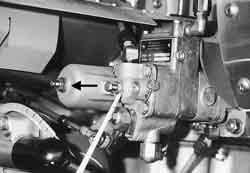
The editors ofLightPlane Maintenance recently looked at the universal as well as unique aspects of the relatively simple TCM continuous-flow fuel-injection system of the 360 engine. They also discuss how to set up and adjust the system for optimum efficiency and control.
This article appears in the October 2002 edition of LightPlane Maintenance, and is reprinted here by permission.
Winston Churchill once said, "Out of intense complexities intense simplicities emerge." Any fuel-injection system is generally viewed as a complex series of events controlled by intricate mechanisms all held together by an intimidating series of checks and balances. While it's true the Continental fuel-injection system is assembled and adjusted using some complex procedures and equipment, the theory of operation is uncomplicated, and troubleshooting and repairs are quite reasonable by aircraft standards.
System Operation
(Click on any photo for a
larger version) 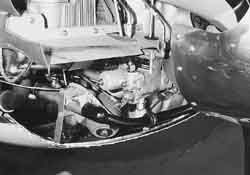
Injection System Installed
All Continental Motors fuel-injection systems are considered continuous-flow injection systems, because fuel is delivered to individual cylinders at a constant pace without regard to intake-valve opening or crankshaft position. These simple systems, while fuel-wasteful by design, eliminate the need for spring-loaded injector nozzles and complex injection-timing devices. Fewer moving parts and relatively trouble-free operation are the trade-off against the efficient burning of fuel and air. There are four basic components to this system, only two of which are field adjustable.
The engine-driven fuel pump sends fuel under pressure to an injector assembly, which controls the amount of fuel directed to the manifold valve. The supply of fuel from the pump is determined by pump speed and relief-valve adjustment. How much of this supply is allowed to flow to the engine is determined by metering valves within the injector assembly. Both the pump and the injector are ground-adjusted to a predetermined fuel-flow rate at any given power setting. A mixture-control feature is included to allow the pilot to override these pre-set adjustments in order to properly lean the engine during cruise.
Metered fuel from the injector is then routed to the manifold valve, which has two main functions. The primary goal is to equally divide metered fuel between all six cylinders. The secondary objective is to provide a positive means of stopping all fuel flow when the mixture control is placed in idle cut-off. From this point, metered fuel is then fed through stainless-steel injector lines to the fuel nozzles. Injector nozzles are equipped with a calibrated orifice installed in the upper chamber, which controls the amount of fuel injected under a set pressure. The lower portion of the nozzle is used as a mixing chamber for fuel that has already passed the calibrated orifice and ambient (or deck) air, which is introduced for atomization.
Whether normally aspirated or turbocharged, operation of this fuel-injection system is the same. Fuel is pumped under a set pressure to the injector, which mechanically calibrates this flood for the power selected and sends the resulting flow through the divider valve (or manifold valve) to the nozzles. Excess fuel is sent back to the fuel pump from the injector to be reintroduced to the pump or returned to the aircraft fuel tanks, as demand dictates.
IO-360 Pumps and Aneroid Valves

Fuel-Injection System Diagram
The Continental 360 engine drives a positive-displacement, vane-type fuel pump, which has the ability to supply over twice the fuel needed for proper engine operation at any power setting. Driven from a pad on the right-front side of the crankcase, the fuel pump takes gravity-fed fuel and boosts the pressure to over 46 psi at takeoff power on some models of the TSIO-360 series engine. In order to get this pressure, the fuel must flow through a series of check valves and adjustable orifices, which adjust flow and pressure for a given engine rpm.
There are two critical adjustments on the fuel pump, and both must be set correctly for proper injection calibration. The low, unmetered-pump adjustment is generally a bolt with a lock nut located on the centerline of the pump. The jam nut is loosened and the bolt is turned clockwise (CW) to increase the low pressure, and counterclockwise (CCW) to decrease the pressure. This adjustment primarily affects low-power, or idle, pump pressures and has little to do with any high-power pump adjustment. At any rpm above 1,500, this low-metered adjustment becomes a fixed bleed and has no substantial effect on high-end fuel flow.
Normally aspirated engines have a fuel pump equipped with a jet plug in the output section of the pump, which bleeds off fuel pressure as it reaches its maximum system output. Normally, non-turbocharged 360 engines have nozzle pressures (or maximum fuel-pump pressures) of 12 -18 psi. Turning the jet plug in will increase the high-end pressure, while turning it out will reduce the pressure to the manifold valve.
Fuel pumps installed on turbocharged engines also regulate fuel-pressure output, but do so by using an aneroid-activated orifice, which responds to turbocharger boost (or deck) pressure. The more boost applied to the aneroid, the more movement allowed on the orifice. In this way, fuel pressure will increase with boost pressure rather than reacting to just engine rpm.
The aneroid does not sense altitude change or atmospheric pressure. It simply provides a balance between sealed aneroid pressure and turbocharger output. High-end fuel flow on this style of pump is accomplished by turning in (CW) on the aneroid to decrease fuel flow and turning out (CCW) on the screw to increase fuel flow. This adjustment, like all aneroid adjustments, should only be made after ensuring that all upper deck reference lines are secure and without excessive leakage.
Also, remember that the aneroid adjustment is a fine-threaded screw with a jam nut. Use care with the lock nut to avoid stripping the aneroid-housing threads.
Differences
The Continental 360 fuel pump differs from the 470 or 520 fuel pump in that the mixture control is part of the pump rather than the injector assembly. A rotary valve will allow metered pressure to flow to the injector assembly mounted on the top of the engine only after flowing through galleys and ports located within this assembly. In the idle cut-off position, all ports and channels are closed and fuel flow stops, regardless of the pump pressure.
Common to all pumps is a check valve that allows the aircraft's electric boost pump to flow fuel through the engine-driven pump in the event of pump failure. While failure is rare, it can happen, and some means to bypass the failed pump is required if we wish to remain aloft.
It should be noted that the Continental 360-series fuel pump is supplied in gear configurations supporting a CW and CCW drive. The Piper Seneca series, for instance, uses counter-rotating engines, which makes the two options a necessity.
Problems with fuel pumps are generally the result of a failure of upper deck reference lines to a pump aneroid or contamination of the poppet valves and main jet orifices. Failure of the drive shaft is almost unheard of unless the pump is allowed to operate dry. Vanes in any type of pump need a fluid for proper lubrication and to seal the pump cavity during operation.
Throttle Body Injectors
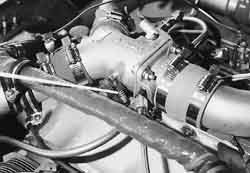
Idle Set Screw
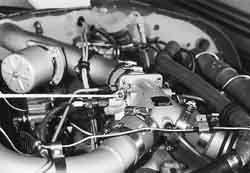
Idle Mixture Adjustment Screw
Fuel pressure from the pump is of little use if we can't control the amount of fuel delivered to the engine for a given power setting. For this reason, the throttle body, or more correctly, the air-throttle metering assembly, is equipped with another rotary valve tied to throttle position. In this way, a more refined and accurately calibrated fuel flow is set to the divider valve. At full power, or at around 40 degrees of throttle opening, the rotary valve has opened the galleys as wide as they'll go. Further increases in throttle opening will not supply any more fuel flow unless a change to turbocharger boost or deck air is realized.
There are two main adjustments on the throttle body, both of which affect only the low-power and idle circuits. On the left side of the unit is a screw and spring arrangement attached to the throttle arm. This is the idle-setting screw. There is an additional set-screw attached to the arm, which is usually held in place with a small lock nut and Locktite material. This screw is used during overhaul to properly adjust the wide-open setting for the butterfly valve in the air-horn assembly. No adjustment to this screw is necessary in the field. On the right side of the injector is a slotted screw recessed within the forward-facing boss of the fuel-metering cover. This is the idle-mixture adjustment screw and it works much like the idle-mixture adjustment in a carburetor. Turning in (CW) on the screw will lean the mixture, while turning out (CCW) will enrich the engine.
After all pump pressures are adjusted, the mixture screw is set for a 25 – 50 rpm rise at idle rpm. The throttle body acts as a metering device for fuel and provides a means to get inlet air to the engine.
There is little to affect the throttle body except possible fuel contamination and leakage past the throttle shaft seals. Recent designs for this component have provided a more positive means to seal the shaft against leakage; however, unlike most fuel injectors, there is no fuel screen in the inlet side of the unit. Whatever passes through the pump, passes through the injector.
Divider Valves and Nozzles
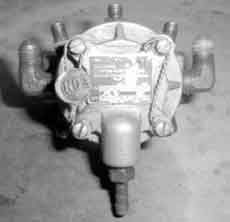
Fuel Manifold Valve (Spider)
Fuel manifold valves, commonly referred to as divider valves or spider valves, provide a means to send metered fuel to all six cylinders in the engine. Fuel pressure is supplied to the valve, which pushes upward on a diaphragm, allowing full flow of all fuel through a screen and to the six ports around the valve body. When inlet fuel pressure drops below three psi, the spring-loaded diaphragm closes the fuel port, effectively shutting off all fuel flow to the injectors. This function is necessary to keep an engine from "running on" when in idle cut-off, and to reduce the vapor-lock potential.
The upper side of the divider diaphragm is vented to atmospheric pressure. A small hole will be drilled in the manifold valve-cover to allow for this venting, or a fitting will be installed to provide for a drain-line attachment. Any blockage of this vent will result in a fuel flow loss at altitude, due to the expansion of the trapped air within the cavity as the aircraft climbs. When the air expands against the diaphragm, the valve is forced downward against its seat, effectively closing off fuel flow through the valve.
Stainless-steel injector lines are used to carry the fuel from the divider to each cylinder in turn. Both turbocharged and normally aspirated 360 engines use the same basic injector lines, identified by part number and cylinder position. For shorter injector lines used in the standard 360 installation, the inside diameter will be 0.069 in., regardless of cylinder position.
Some TSIO-360 installations require injector lines with an average length over the standard 14 – 17 inches. For those lines, the inside diameter will measure 0.100 in. Don't confuse or mix the two. Contrary to popular belief, injector lines don't need to be the same length. They do, however, need to have an equal pressure drop for all cylinders.
Fitting ends on these lines are silver-soldered together, and cracking is common at the joints, especially on older aircraft. Watch for abrasions and fretting of the outside diameters and make certain that the lines are properly supported throughout their lengths.
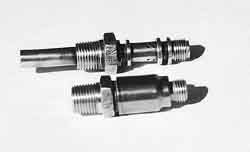
Injector Nozzles (top: Turbocharged; bottom: Normal)
Injector nozzles are supplied in two types with a variety of sizes stamped on one of the six hex flats around their circumference. Normally aspirated engines take a nozzle, which is equipped with a fixed, calibrated orifice and has a series of holes drilled just below the orifice chamber for air entry to the lower chamber.
A screen covers this part of the nozzle and a stainless-steel shroud is swaged tightly around the neck of the injector. As fuel passes through the calibrated orifice to the lower chamber, ambient air is pulled under the shroud and through the screen, finally mixing with the fuel as it is sprayed into the intake port. Because no air is pulled in during start, raw fuel will sometimes gather in the intake port and cylinder drain tubes, allowing for rough running and "cold" operation until the excess fuel evaporates.
Nozzles used in turbocharged aircraft are slightly different in look but operate exactly the same way. Instead of pulling in ambient air to mix with the fuel, turbocharger output air is routed to a shroud surrounding the nozzle, and deck air is pushed into the injector for atomization. Because this deck air is also referenced to the fuel pump, any leakage past the shroud seals or upper deck lines will affect the turbocharger output sense to the fuel-pump aneroid. While the upper-deck lines are usually a loose fit (and should be), excessive leakage will result in rough running and loss in high-end fuel flow.
All injector nozzles should be cleaned on an annual basis in an ultrasonic cleaner with a good carbon-dissolving agent. Soaking in a bottle of MEK and blowing dry with compressed air may not be good enough to get them as clean as they should be. Pushing a wire or similarly pointed device through the orifice is a moronic, cheapskate approach.
Poor atomization and isolated hot spots (or cold spots) can alter the combustion process and, in the worst of cases, ruin a cylinder under high loads and peak demands. Keep the nozzles clean and free from internal scratches or dents. It does no good to adjust the fuel-injection system to the proper specs if the nozzles won't mix the appropriate amount of air and fuel at the right point, sprayed in the right direction.
System Set-up and Adjustment
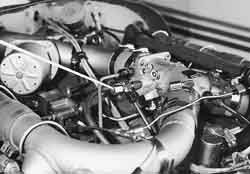
Pressure Calibration Port
Before any adjustments are made to the fuel-injection system, make certain that any intake or exhaust leaks are fixed. Clean and gap the plugs, and check the main fuel screens for contamination. Inspect and replace the seals on any defective upper-deck lines, and service the injection nozzles. In short, any routine maintenance item related to the injection system should be serviced prior to making an adjustment that could compensate for a deficiency somewhere else in the system.
Once all peripheral system concerns are satisfied, you will want to open a copy of Continental Service Bulletin #M89-10 and find the correct specifications for the model of 360 you have. For those operating a turbocharged version of the 360, look in the aircraft maintenance manual for information on positioning of the wastegate plug depicted by the number of threads exposed above the pipe. A quick check here is helpful in making sure you're getting the proper throttle deflection angle when at full power.
Some manuals call for red-line manifold pressure to be achieved at a set throttle position on the quadrant in the cabin. No matter how the position is depicted, this must be done first in order to get the correct amount of fuel past the rotary metering valves at the proper pressure.
Unlike most fuel-injection systems, the IO- and TSIO-360 fuel-injection system provides a handy fitting located on the outboard, right side of the throttle body. This -4 fitting will accept your 0 – 60 psi gauge with little difficulty and is absolutely necessary for proper system adjustment. A steel cap closes this fitting off during normal service.
Attach a known accurate gauge to the fitting with a length of hose that allows the positioning of the gauge somewhere to the rear of the engine. Keep the gauge on the same level, or very near the same level, as the pump in order to eliminate head pressure errors. Secure the gauge to a hose or some flexible piece with tie-wraps.
Next, back the idle speed screw off its stop. When idle mixtures and low-unmetered fuel pressures are changed, the engine idle will be affected by the change in mixture ratios. For this reason, it is preferable to set idle rpm with the throttle until all adjustments are finished. The engine should be sufficiently warmed up and "loading" of the induction should be allowed to clear before making any adjustments.

Low-Unmetered Fuel Pressure Adjustment (white pointer) and High Fuel Flow Adjustment (black arrow)
The low-unmetered fuel pressure is set first using the bolt located along the centerline of the fuel pump. At idle rpm, the pressure is set per the chart listed in SB #M89-10. Typically, this figure is 6.5 psi at 600 rpm for most engines. Refer to the chart found in the bulletin for your specific engine model.
After setting this pressure, check the engine for a 25 – 50 rpm rise when pulling the mixture back to idle cut-off. Adjusting the low-unmetered pressure has a big effect on the mixture setting, but any adjustment to one will affect the other.
Adjust the recessed slotted screw in the air-metering unit to get the proper rise in mixture and recheck the low-unmetered pressure when finished. This procedure can go back and forth for a time until the balance is made.
It may be beneficial to accelerate the engine through about 2000 rpm every so often to keep the induction from loading up during the ground runs. After the adjustments are made, secure the lock nut on the low-pressure adjusting bolt. The mixture screw has no particular lock feature. The stiffness of the assembly seems to hold the screw sufficiently tight in its boss.
High-end fuel flow adjustments can only be made after running the engine at full power and, of course, only while using the mixture control in the full-rich condition. Because our fuel-pump adjustments are primarily based on engine rpm, the engine must reach redline rpm in order to get an accurate description of fuel flow.
Some aircraft will need to be flown or taxied down the runway in order to get enough airflow through the propeller for high-rpm limits. Few Continental 360s are affected by this, so a static run will probably be sufficient.
High-end fuel flow is set using the aircraft fuel-flow gauge as the master instrument. Our 0 – 60 psi gauge is installed as a backup to the aircraft gauge, and a cross-check can be made to insure that the panel gauge is more or less accurate.
Slowly advance the power until maximum rpm and manifold pressure is reached. On a normally aspirated engine, high-end fuel flow will be set using the jet plug adjustment located on the side of the pump. Turn the adjusting screw CW to increase the fuel flow and CCW to decrease the flow.
It should be noted that normally aspirated engines using the Continental fuel-injection system will indicate maximum fuel flow regardless of pressure altitude and manifold pressure. The setting is purely a function of engine rpm, and the mixture must be manually leaned for maximum power at higher airport altitudes.
Turbocharged engines are adjusted in the same fashion. In place of the jet plug, there is an aneroid tower with an exposed jam nut and adjusting screw. Maximum manifold pressure will be achieved at 40 degrees of throttle opening or some predetermined throw on the throttle. This is set by adjusting the wastegate plug in or out to get the right manifold pressure at the right time.
The plug is very tight in its bore due to the extreme heat associated with the unit, and lots of penetrating oil will be necessary if you expect to break it free. Use care here because many wastegate plugs are ruined due to stripped threads and seized fittings.
Fuel flow is adjusted by loosening the lock nut and turning the adjusting screw on the tower CW to decrease the pressure and CCW to increase the flow. Again, all high-end adjustments are made with the mixture control in the full-rich position.
Use care in accelerating the turbocharged version of the Continental 360 engine. A fixed wastegate can allow for an overboost condition quite easily, and engine acceleration is very rapid after turning through 2200 rpm.
Cleaning Up and Fail Modes
Once the high-end adjustments are made, recheck the low-unmetered pressure and mixture settings again. They should not have changed much but sometimes a full-power run will alter a low-flow setting. Position the throttle to give you the specified hot-idle rpm, and lock the friction control. When the engine has been shut down and the fuel turned off, you can adjust the idle screw to contact its stop and remove the gauge from the air-metering assembly.
Flight testing the aircraft is always recommended, and minor adjustments might be made after the flight. Turbocharged aircraft should perform a critical-altitude flight in order to ensure that any adjustment to the wastegate plug has no deleterious effect on performance.
As always, if an adjustment makes no difference in the operation, or if a component will not "dial in" to a target pressure, then the offending component is usually the one being adjusted. Before removing and replacing components, though, make certain that all other potential problems have been eliminated.
Given enough fuel supply and a nominal amount of engine rpm, the simplicity of the Continental Fuel-Injection System will show itself in long, trouble-free operation.
Source: https://www.avweb.com/ownership/continental-io-360-fuel-injection/
0 Response to "Continental Motors Continues Fuel Injection System"
Post a Comment